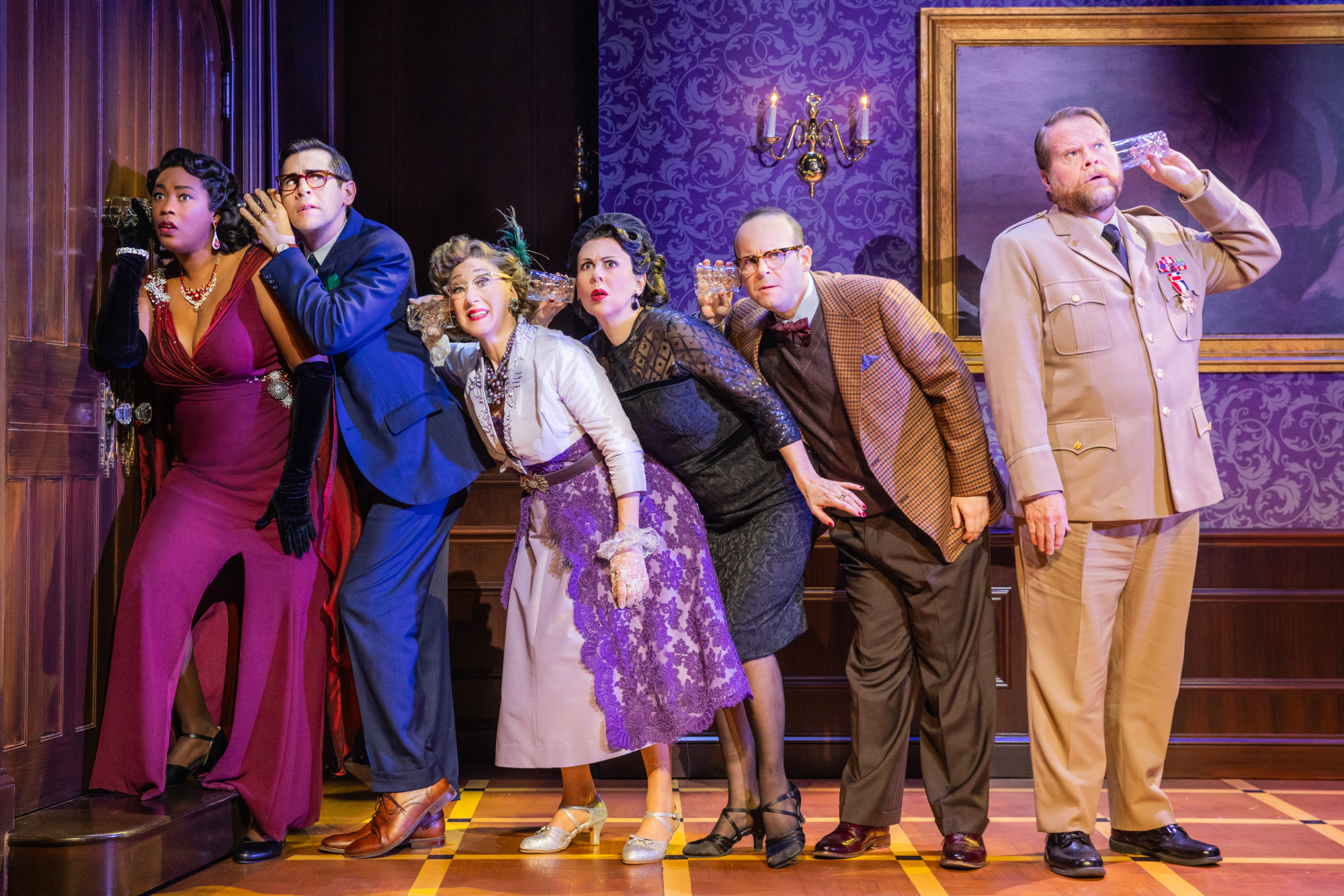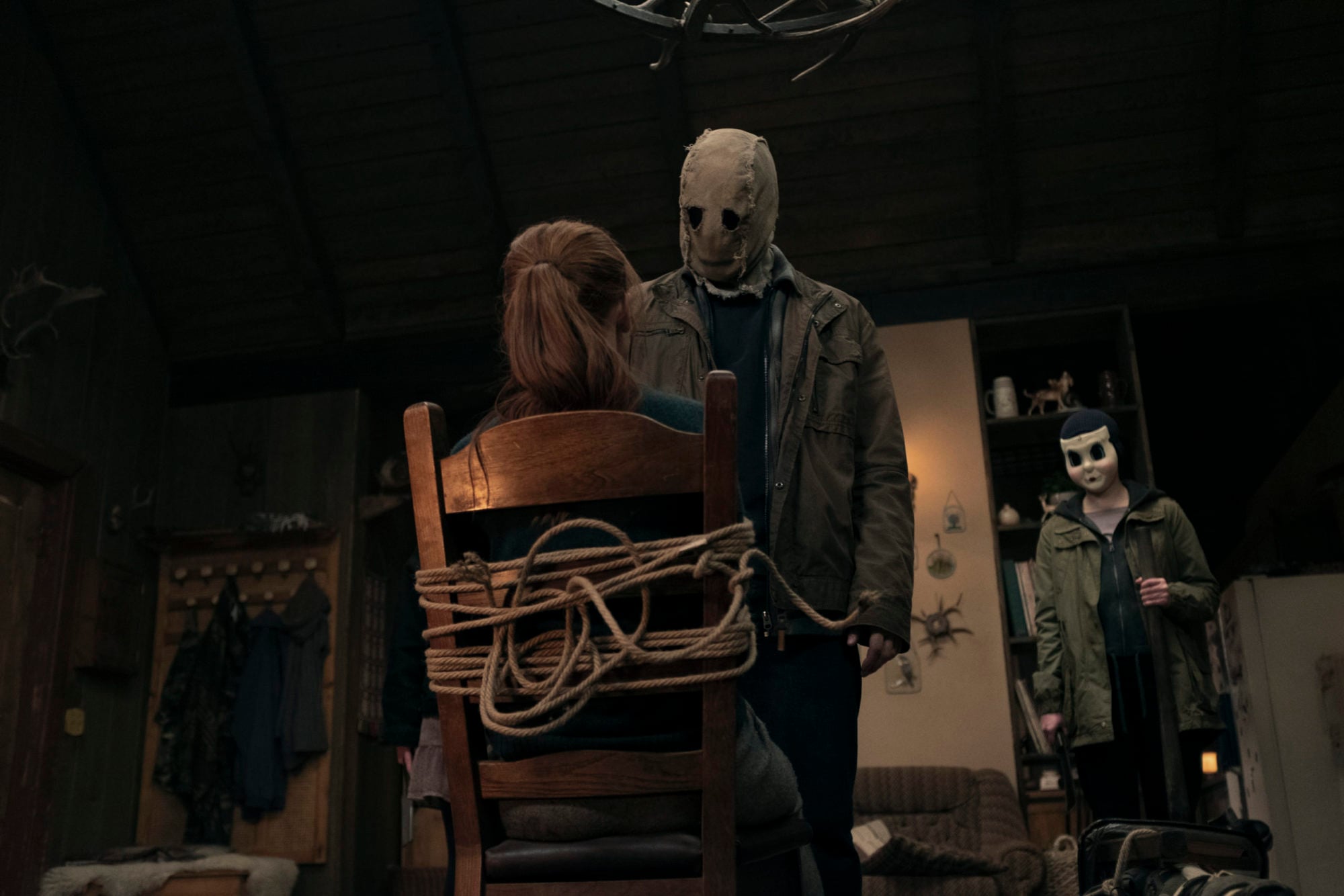Reviews
‘Clue: A New Comedy’ Stage Play Is a Slapstick Slasher That Lovingly Adapts Hasbro’s Board Game

The national tour of ‘Clue: A New Comedy’ remixes the classic murder mystery with farcical physical comedy and impassioned old-fashioned sensibilities.
“It’s all part of the game.”
There’s a strong relationship between mischievous murder mysteries and the horror genre. Murder mysteries inherently hinge upon death – it’s baked into the name – so it’s not surprising that horror has embraced this secretive subgenre and really emphasized the murder in murder mysteries. Murder mysteries have been popular in pop culture for nearly a century. However, there’s been a recent renaissance on this front with playful films like Knives Out, A Haunting in Venice, Bodies Bodies Bodies, the Scream franchise, and the prominence of the true-crime genre and armchair detectives. That being said, an underrated and evergreen source of murder mystery hijinks that’s entertained audiences for 75 years is Hasbro and Parker Brothers’ Clue.
Clue has experienced many permutations over the years, including Jonathan Lynn’s 1985 cult classic film and several stage adaptations. In a new dawn where board game and toy IP are at an all-time high, a new stage adaptation of Clue has been put together by Sandy Rustin, with additional material by Hunter Foster and Eric Price, and directed by Casey Hushion. Hushion’s Clue: A New Comedy, which is in the middle of a national tour, effortlessly harkens back to vaudevillian silliness and broad laughs, while it simultaneously explores darker genre impulses and intrigue. It’s the perfect way to nostalgically celebrate the ’80s movie, but also remind audiences why Hasbro’s upcoming cinematic remake is long overdue.
Hushion’s Clue is an adaptation of Lynn’s ‘85 film, but it still brings many original ideas and revisions to the table so that this doesn’t just feel like a stripped down version of the movie. Clue: A New Comedy finds immense pleasure in how it translates the game’s rules so that it functions as a faithful adaptation of the game and the feature film, while it also becomes a fun, fresh entity that’s a living hybrid of both. In Clue: A New Comedy, blackmail functions as the story’s central mystery, just as it does in the board game and cinematic adaptation. Each color-coded houseguest has terrible secrets that they don’t want getting out, which becomes the impetus for the growing body count.
Clue is a comedic character study and this stage play presents well-defined individuals who are easy to identify and connect with, despite their one-dimensional nature. Mr. Green (John Shartzer) is the cast’s real standout, but there’s not a single weak link among Clue’s eight central players. Clue’s best moments are the ones when the whole cast gets to bounce off of each other and revel in the group’s chaotic energy. The play’s ‘50s McCarthyism setting also adds an extra layer of mistrust, paranoia, and subterfuge to the equation that still feels timely in its own way. Farcical, broad wordplay – especially from John Treacy Egan’s Colonel Mustard – are a delight and reminiscent of an old-fashioned radio play when it comes to Clue’s jokes, timing, and dialogue.
Beyond Clue’s script lies some exceptional physical comedy, particularly from Shartzer’s Mr. Green. There are broad group reactions that play out in unison for mass comic effect, as well as lighting cues that brilliantly accentuate punchlines and become a solid running gag throughout the 90-minute show. There are playful movement exercises that are expertly choreographed and verge on interpretative dance. Clue adopts a real Scooby-Doo energy to the production, especially when it comes to its scene transitions. Clue even indulges in a “multiple door chase sequence” that taps into the right energy for this degree of slapstick. To this point, there’s an absolutely brilliant slow motion sequence that’s a highlight of the show and adeptly incorporated.
Clue’s characters are its secret weapon, but stellar production elements help elevate the stage play to something truly special. There’s really powerful set design by Lee Savage that evokes a creepy, cozy Haunted Mansion aesthetic that’s the right atmosphere for this murder mystery tale. Clever design decisions result in rotating walls and rooms that economically get the most out of the stage’s environment. Clumsy execution of these elements would quickly sink Clue and ruin its crescendoing quality. They’re seamlessly handled, as are Ryan O’Gara’s evocative lighting design and Michael Holland’s jauntily creepy musical cues. All these elements work together to make sure that Clue is as visually entertaining as it is well-acted and written.
Clue: A New Comedy goes all-in on its laughs. That being said, the play’s death scenes are actually creepy and immaculately orchestrated with all the finesse of peak genre cinema. There are genuine slasher vibes present that pulse through the show’s pervasive slapstick silliness. It’s a testament to the sheer artistry of craft in Clue that both of these extremes work as well as they do. Clue also shrewdly embraces the infamous multiple ending angle that helped give Lynn’s feature film a smart extra meta layer to its storytelling. It’s fun, different, and takes advantage of the medium of theater to great effect. It’s also the satisfying culmination of a story that gets progressively manic, unhinged, and verges on collapsing in on itself by the end – but in the best way possible. Clue pushes boundaries with tone and control like an expert puppet master.
Clue: A New Comedy hits all the right notes and succeeds as a breezy piece of theater that celebrates whodunit hijinks, broad buffoonery, and wicked wit. It’s Agatha Christie meets Frasier. Clue is a show that definitely prioritizes comedy over horror and suspense, but there’s enough style in this production to properly sell the production’s more evil impulses. It’s unlikely that anyone will be genuinely frightened, yet the play will still keep audiences on the edge of their seats and eagerly anticipate who’s responsible for Boddy Mansion’s copious corpses. Clue: A New Comedy is the best way to experience the Hasbro and Parker Brothers classic before its next cinematic adaptation proves that murder and mayhem aren’t just a game anymore.
Go to Broadway.org to see if ‘Clue: A New Comedy’ will be coming to your area.


Photo by Evan Zimmerman for MurphyMade

Reviews
‘The Strangers: Chapter 1’ Review – New Trilogy Kicks Off with a Familiar Start

Rebooting and expanding upon Bryan Bertino’s chilling 2008 horror film in a brand new trilogy, all installments already shot as part of one continuous, overarching story, makes for one of the more ambitious horror endeavors as of late. It also means that The Strangers: Chapter 1 is only the opening act of a three-part saga. Considering it’s the entry most committed to recreating the familiar beats of Bertino’s film, Chapter 1 makes for a tricky-to-gauge, overly familiar introduction to this new expansion.
The Strangers: Chapter 1 introduces happy couple Maya (Madelaine Petsch) and Ryan (Froy Gutierrez) on their way to starting a new life together in the Pacific Northwest. Car troubles leave them stranded in the quirky small town of Venus, Oregon, where they’re forced to stay the night in a cozy but remote cabin in the woods.
Naturally, the deeply in love couple soon find themselves in a desperate bid to survive the night when three masked strangers come knocking.

Madelaine Petsch as Maya in The Strangers. Photo Credit: John Armour
Director Renny Harlin, working from a 289-page screenplay by Alan R. Cohen & Alan Freedland that was broken into three movies, keeps Chapter 1 mostly self-contained to recapture the spirit of the original film. The core remains the same in that it’s reliant on the eerie stalking and escalating violence that builds toward a familiar conclusion, but Harlin mixes it up a bit through details and set pieces that hint toward the larger story around Venus itself. The early introductory scenes establishing both the protagonists and their setting offer the biggest clues toward the subsequent chapters, with the bustling diner giving glimpses of potential allies or foes yet to come- like the silent, lurking Sheriff Rotter (Richard Brake).
One downside to announcing this as a trilogy is that we already know that the successive chapters will continue Maya’s story, robbing more suspense from a film that liberally leans into its predecessor for scares. The good news is that Madelaine Petsch brings enough layers to Maya to pique curiosity and instill rooting interest to carry into Chapter 2. Maya begins as the gentler, more polite half of the young couple in love, but there’s a defiance that creeps through the more she’s terrorized. On that front, Petsch makes Maya’s visceral fear tangible, visibly quaking and quivering through her abject terror as she attempts to evade her relentless attackers.

The Strangers – Chapter 1. Photo Credit: John Armour
It’s her subtle emotional arc and quiet visual hints toward the bigger picture that tantalize most in an introductory chapter meant to entice younger audiences unfamiliar with the 2008 originator. The jolts will have a harder time landing for fans of Bertino’s film, however, even when Harlin stretches beyond the cabin for stunt-heavy chase sequences or gory bursts of violence. It’s worth noting that Harlin’s tenured experience and cinematographer José David Montero ensure we can grasp every intricate stunt or chase sequence with clarity; there’s no worry of squinting through the dark, hazy woods to make out what’s happening on screen. A more vibrant color palette also lends personality to Venus and its residents.
The Strangers: Chapter 1 exists in a unique place in that it’s the first 90 minutes of what will amount to a roughly 4.5-hour movie yet doesn’t give much away at all about what’s ahead, presenting only part of the whole picture. Chapter 1 does a sufficient job laying the groundwork and delivering horror thrills but with a caveat: the less familiar you are with The Strangers, the better. Harlin and crew get a bit too faithful in their bid to recreate Bertino’s effective scares, even when remixing them, and it dampens what works. The more significant departures from the source material won’t come until later, but look to a mid-credit tease that sets this up.
The Strangers: Chapter 1 doesn’t establish enough of its own identity to make it memorable or set it apart, but it’s just functional enough to raise curiosity for where we’re headed next.
The Strangers: Chapter 1 releases in theaters on May 17, 2024.












You must be logged in to post a comment.